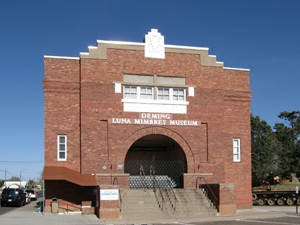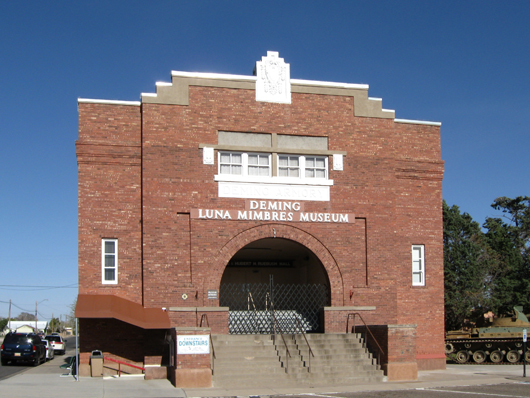
DEMING, N.M. (AP) – You wouldn’t know it from its austere exterior, a former Armory built in 1918, but inside, the Deming Luna Mimbres Museum is as warm and inclusive as a bulging family photo album.
If the brick facade seems to say “you cannot pass,” the museum staff says “all are welcome.”
Inside, visitors encounter a dizzying variety of items, sometimes perplexing, always fascinating, in the halls of the 30,000-square-foot museum: from hundreds of dolls dating from the 19th century through the 1970s, fine examples of Mimbres pottery, war memorabilia and a room crammed with whiskey bottles in every conceivable shape, from the Pope to leprechauns to Spock from Star Trek.
Museum administrator Virginia Pool says the institution’s roughly 13,000 annual visitors, the bulk of whom arrive during winter with the snowbird invasion, are charmed by the diversity.
“We get comments all the time, they call it ‘the little Smithsonian,’” said Pool. “When you look around, we’ve got something for everybody. Whatever a person’s interests are, we’ve got something for them. That’s what I love about it.”
Dr. Jerry Brody, retired professor of anthropology at the University of New Mexico and former director of the Maxwell Museum, said that for community-based museums that rely on donations from local residents, having a wide-ranging collection “comes with the territory.” But, Brody said, that’s not a bad thing.
Brody said that Deming’s museum, run and managed by a staff that is all volunteer with the exception of a custodian, is one of his favorites. In the Albuquerque Archaeological Society Newsletter some years back, Brody wrote that the Deming Luna Mimbres Museum “is the only volunteer-begun, volunteer-run, low-budget museum that I know of to not only survive for a full human generation, but also to flourish.”
Las Cruces resident John Porter Bloom, a former historian with the National Park Service and an at-large board member of the Historical Society of New Mexico, called the museum “terrific.”
“It’s head and shoulders above anything in any town of its size anywhere in the United States,” Bloom said. “I’d bet you $10 to a doughnut on that.”
Fittingly enough, the museum made its way to the landmark Armory building in 1977 in order to display the town’s first powered washing machine.
The washing machine was once owned by the mother of a local businessman, Hubert Ruebush. When it was purchased in 1921, curious residents came from all over the town to see it work, according to a booklet written by former museum director Ruth Brown.
Ruebush wanted to give the washer to the Luna County Historical Society, but the organization, then renting a four-room house on Nickel Street for a museum, had little display space, so Ruebush suggested buying the National Guard Armory then for sale.
Ruebush put up half the money for the purchase, and local residents raised the rest, Brown said.
Funded largely by a state appropriation combined with help from Deming and Luna County, the museum completed a $1.1 million renovation project in 2007 to install new flooring, an elevator, restrooms and a new heating, ventilation and air conditioning system.
From its opening in the Armory, the museum displayed items of local historical interest, such as an upright Steinway grand piano and late 19th-century dresses worn around the time of the town’s founding in 1881 when the Santa Fe and Southern Pacific railroads completed the nation’s second transcontinental railroad.
Soon after the new museum’s first open house, the wife of a Michigan transplant, who became the museum’s director, donated her collection of dolls, including many China dolls, some dating to the early 19th century.
That gift, it turned out, was the first of many from local residents that would reflect individuals’ passions or hold some strong personal value. So, the doll collection, housed in a former small arms firing range, has grown with other gifts. It now includes kitsch (a 1963 Bam Bam doll from the Flintstones cartoon series and a 1977 replica of actress Kristy McNichol) along with an eerie Japanese doll, undamaged, that an American sailor from Wisconsin plucked from the rubble of the atomic blast in Hiroshima in 1945.
The Japanese doll, acknowledged assistant director Katy Hofacket, has no real connection to Deming. But the veteran, after visiting the museum, “just thought it should have a good home,” and the museum accepted, she said.
Other rooms in the museum are dedicated to an impressive collection of Mimbres pottery and other artifacts donated by two local ranchers in the mid-1990s; thousands of fossils, geodes and thunder eggs donated by world-renowned collector Robert Colburn; military relics, some dating back to an 1860s fort, up to more modern conflicts. Visitors can inspect handcrafted saddles and a chuck wagon reflecting ranching and cowboy culture, and see examples of local fine art and quilts.
The museum’s Main Street room includes detailed representations of local storefronts from yesteryear, like a barbershop, a mercantile and a beauty shop, each housing equipment from the past. The room includes the town’s first traffic light and the first car owned by a local resident, a 1904 Reo.
The museum covers the gamut of Deming’s social life, with fine china from local families on the first floor and, on the second floor, the wooden-wheeled hand cart from which a local man, Leonardo Reyes, sold tamales in the city’s downtown from the 1930s to the early ’50s.
Visitors looking to be surprised by wonderfully odd exhibits will not be disappointed. Spend time on the second floor and one will encounter, near a display of Alaskan native artifacts, cases with scores of tiny hand bells from around the world as well as one late local’s nearly 200 button hooks from a bygone era. On the ground floor there is a horse-drawn sleigh, built in Michigan in the early 1900s, that probably got little use in the Chihuahuan desert, but was acquired by a local.
“Sometimes we just get things that we think are really cute,” Hofacket said.
And somewhere in the museum’s storage, Pool said, is a rare early edition of Playboy magazine—in braille.
___
Information from: Albuquerque Journal, http://www.abqjournal.com
Copyright 2012 Associated Press. All rights reserved. This material may not be published, broadcast, rewritten, or redistributed.
AP-WF-01-01-12 1903GMT
ADDITIONAL IMAGE OF NOTE



